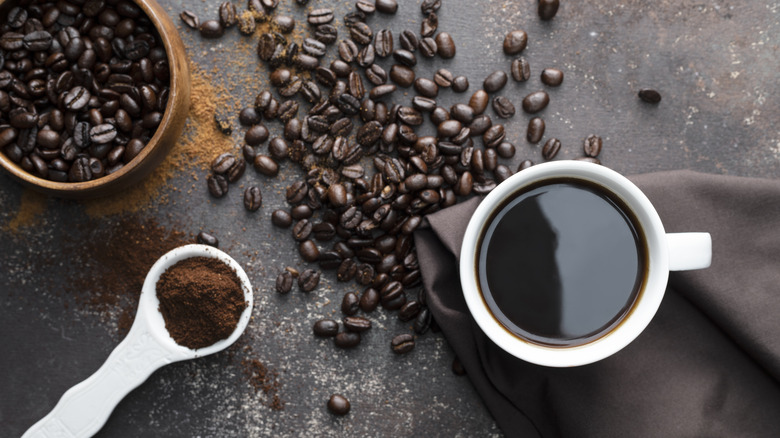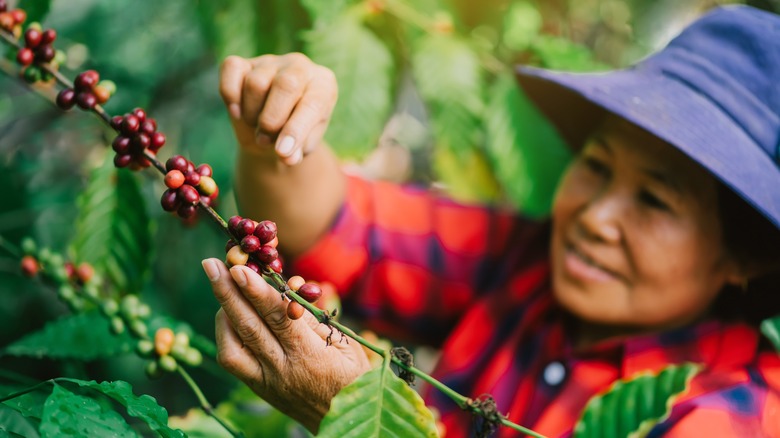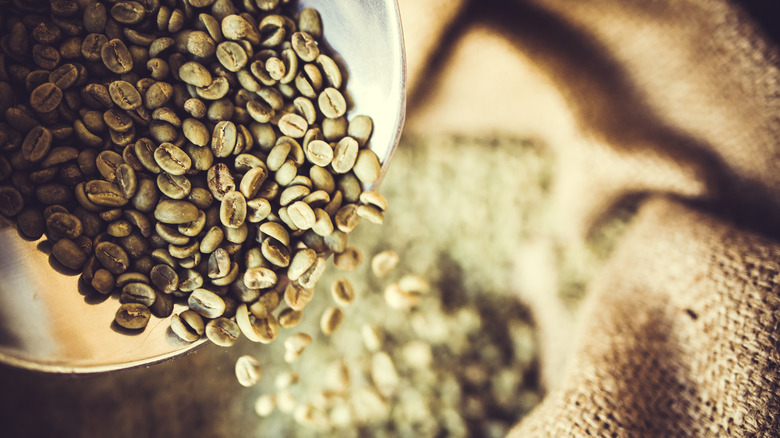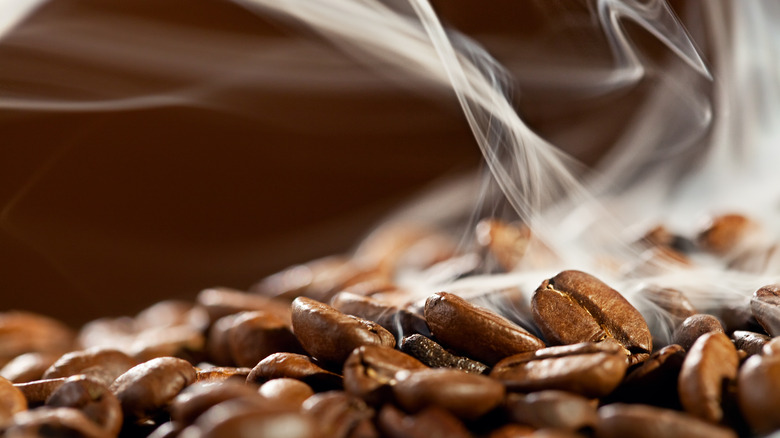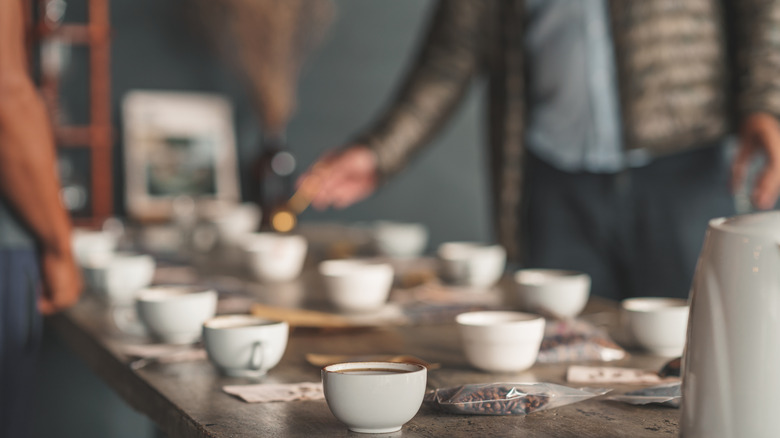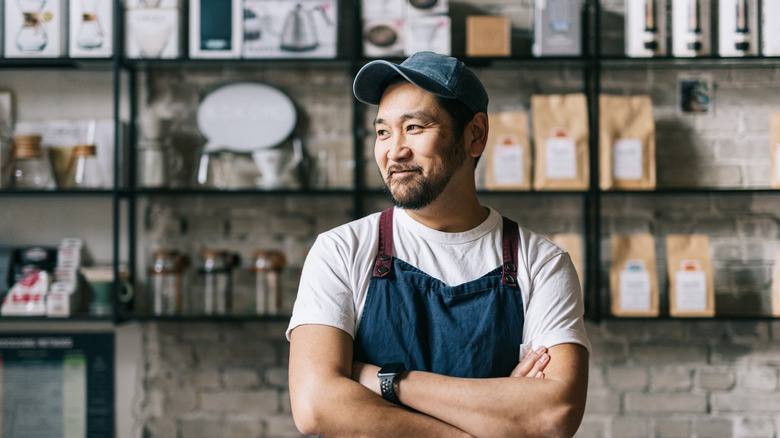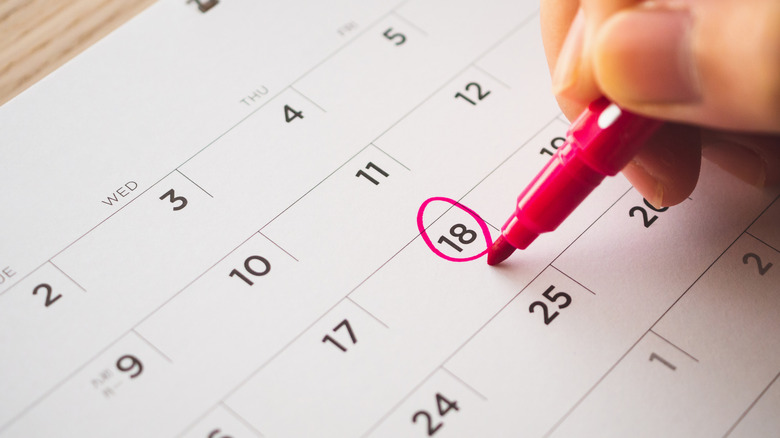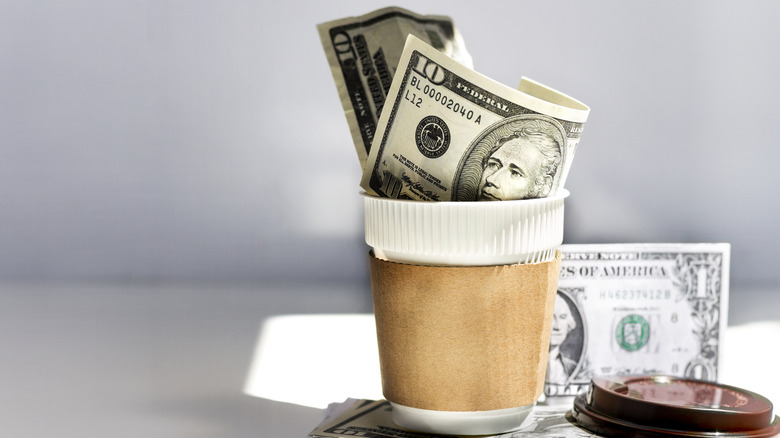How To Buy And Store Specialty Coffee Beans, According To An Expert
There are very few universal truths. But here's one: Coffee is good, and good coffee is better. It doesn't matter whether you're making cold brew or Chemex, fine-tuning your French press, or dialing in the crema on your espresso machine, to get the best finished product, you're going to need to start with quality ingredients. That means specialty coffee beans, with sales making up almost half of the global coffee market despite making up less than 10% of production.
To get the skinny on the best of the best, we sat down with Sergio Hernandez, owner and roast master at Gratitude Coffee Makers in La Paz, on the Baja California Peninsula, to learn just what makes specialty coffee "special" — not to mention where it comes from, where to find it, and what to do with it.
In short, the seeds of the coffee plant (what we call coffee beans) can be broken down into two major categories: specialty and commodity. The selections offered in the grocery store or at the large coffee chain are typically commodity coffee beans that are machine-picked, sold in bulk, mixed together, and roasted at high temperatures to mask flaws and ensure uniformity. Specialty coffee, on the other hand, is hand-picked and must be graded by one of a handful of organizations worldwide in order to ensure high quality with minimal defects. As Hernandez tells us, "Everything in coffee sells, right? ... But quality determines how much someone will pay for it."
Coffee growing regions
Coffee is primarily grown in what is known as the "Bean Belt," a delightfully named horizontal band that wraps the earth between the Tropics of Cancer and Capricorn. Within this ring, we have three primary geographical areas – the Americas, Africa, and Asia – and within these lie over 50 coffee-producing countries, all offering unique characteristics based on factors such as climate, elevation, and soil content.
The Americas is both highly productive and lauded, with Panama, Colombia, and Costa Rica, among others, consistently producing some of the most highly-rated coffees in the world. While each producer is unique, Latin American coffees tend to have a medium body, mild acidity, and notes of chocolate, nuts, and caramel. Looking for an up-and-comer? Hernandez says that El Salvador is a modern model for coffee culture because the government has invested to promote quality and farmers process coffee as a co-op, ensuring that their product is among the best in the world.
Craving a clean, floral cup? Africa might be your next go-to. Known as the birthplace of coffee, Africa's offerings are distinctly world-class with regions including Kenya, Uganda, and Ethiopia offering fruit-forward complexity, balanced acidity, and a smooth finish. Asian varieties, on the other hand, tend to lean toward the rich, herbal, and spicy side, with standouts like Sumatra and Java offering deep, rich, and indulgent coffees.
Trust the process
Coffee's journey from plant to cup is known as processing, which means transforming the cherry of the coffee plant into ready-to-be-roasted green coffee. This typically involves one of three main methods or processes: natural (or dry), washed, and honey. To keep things simple, imagine the natural process as cherries basking in the sun, fully drying out before the removal of the beans. The resulting coffee boasts sweetness and fruitiness with toned-down acidity. On the flip side, the washed process involves submerging the cherries in a water bath — usually for 24 to 72 hours — before the pulp is meticulously removed and the beans are dried solo. The result? A more consistent coffee yield with more of the fruit's natural acidity.
Completing the trio is the honey process, a charming hybrid of natural and washed. With a portion of the pulp left on, it lets some of the natural sweetness shine during drying yet still maintains the crisp acidity that the washed process offers. This honey process boasts a spectrum — black, red, yellow, and white varieties. Black, the sweetest, retains the most fruit, while white offers more acidity.
The decision on which process to use lies with the coffee producers and is ideally based on enhancing the flavors inherent in the beans. Hernandez notes, however, that it's crucial to recognize how limited access to water plays a role in restricting the options of certain farms.
Different types of coffee roasts
Once coffee completes processing and drying, it lands in the hands of roasters, from big coffee factories to cozy little cafes. Coffee roasts come in all sorts, but we can generally group them into four styles: light, medium, medium-dark, and dark.
Starting with the lighter roasts, you can expect clean, citrusy cups that pop with acidity, a lighter feel, and a bit more caffeine kick. Now, as we dance down the roast spectrum, things get darker and that's when you can expect oils to start making an appearance, giving you a fuller body, less caffeine, and a symphony of smoky, bitter, and sweet caramel notes. Think French and Italian roasts for that deep, dark magic.
Hernandez says it's like playing matchmaker between the coffee beans and the roasting process, looking for that sweet spot. He stands in front of a glass wall covered in equations and graphs, breaking down the science behind it all. "Altitude, humidity, water hardness, minerals in the soil of the region, and of course the process itself," he tells us. Each of these factors comes into play when determining the ideal roast. And still, he takes the time to experiment with each new coffee variety he gets his hands on, roasting beans up to nine different ways, before beginning a practice known as cupping, in which he brews each roast, then tastes and tests the aromas and flavors of each one until he finds the version that really lets the bean shine.
Single origin vs. blends
At a fundamental level, the distinction between single-origin coffees and blends is pretty straightforward. Single origins, true to their name, hail from a specific area—whether it's a single farm, cooperative, or small region. On the flip side, blends offer a harmonious mix of coffees from various locales which are carefully crafted by roasters to balance strengths and mask weaknesses. The ideal result is a well-rounded cup, albeit one that might lack the distinctive peaks and valleys found in single-origin coffee.
Hernandez draws a parallel to exploring wine, saying that while a blend may be a crowd-pleaser or even a great daily drinker, true knowledge emerges from experiencing the purest expression. He suggests that for those eager to delve into the realm of specialty coffee, the journey should begin with single-origin beans."On a single origin, single-origin beans allow you to taste all the unique attributes and flavors that the bean has," Hernandez says. "And once you've found some that you enjoy, you'll be even more knowledgeable about choosing a blend that uses those beans."
Where to find coffee
For the best and freshest option, Hernandez recommends you buy local whenever possible. "And when you look at origin nowadays, like from I would say within the last seven years or so, many more micro-roasteries have begun to have access to high-quality, hand-selected coffees," he says. So, don't be afraid to ask your favorite coffee shop if the team roasts their own beans. If they don't, most shops have no problem telling you exactly what roaster source their coffee from. They may even let you see and smell the different beans offered, allowing you to find your perfect match.
If you don't have time to beat the streets in your hometown in search of the perfect roast, many small-batch coffee roasters and larger roasters offer delivery via online shops or subscription services where you can customize everything from the amount of coffee you receive to the roast level and frequency of delivery. Check out roasters with nationwide delivery like Black Oak, Counter Culture, and Stumptown. To really explore without leaving your living room, Trade Coffee teams up with small roasters from around the country and even has a quiz to get you headed in the right direction.
Traveling or just moved to a new city? Hernandez recommends you look up roasters in your state, or better yet, head to a coffee shop and ask around. There's a good chance you'll end up with both a great cup of coffee and good conversation.
Check the date
Hernandez suggests letting the coffee rest for at least three to four days in order to settle down after its roasting rollercoaster. Think of it like resting a steak after cooking, it's good, but it's going to get better.
After this chill-out phase, Hernandez notes that our coffee's peak freshness typically lasts up to a month, depending on the roast style. The lighter roasts, with their zesty acidity, tend to have a longer shelf life, holding onto that fresh kick. Meanwhile, the darker roasts, with their bolder flavors, tend to lose their charm a bit faster. After about four or five weeks, while your coffee won't go bad, it won't be everything it once was, with flavors and aromas getting lost over time.
To keep you right in the sweet spot, look for the roasting date hand-written or printed on the package. Or ask your barista. If you're buying from a shop that roasts its own beans, chances are they're doing this dance weekly to keep things fresh. On the other hand, if you spot a bag that looks like it's been collecting dust for months, it might be best to make your coffee run elsewhere. Freshness matters.
Storing beans at home
Now that you've got those precious coffee beans nestled safely at home, ensuring their peak freshness becomes a top priority. Rest easy, you'll be happy to know that keeping coffee beans fresh is not a complicated process. For the very best results, you'll want to store your coffee as whole beans, taking care to keep it away from light and humidity, then grind it just before brewing.
Now, if you're a gadget person, there are quite a few coffee storage canisters out there to pique your interest, though there is some debate as to whether coffee storage is worth the price. For the more budget-conscious, a mason jar tucked away in a cabinet does the job perfectly, and, if you plan on consuming your coffee within a week or so, even the bag they came in works just fine.
Hernandez does have one more thing to add: "In the fridge, don't do it. Coffee is like a sponge. It will absorb all the odors and flavors of everything around it. No one wants coffee that tastes like fish." We couldn't agree more.
The cost of coffee
Alright, let's break down the reality: Yes, diving into the world of specialty coffee means opening up your wallet a bit wider. Perhaps a lot wider becasue coffee prices have increased rapidly. On average, be prepared to shell out $16 to $25 for a 12-ounce bag. That's at least two to three times more than the run-of-the-mill beans found at the store. It's worth noting, however, that this price gap shrinks when you're eyeing certain "high-end" commodity coffees. Here's a hint, if you can't find an origin for the beans, it's not specialty. Now, you might be asking, is it worth it?
Here's the lowdown: Specialty coffee isn't just a cup of joe; it's a multi-faceted process. There's a comprehensive certification journey, yearly check-ups to maintain standards, and a literal hands-on approach to picking each cherry at its peak ripeness. Add to this the fair wages paid to farmers and the delicate balance of art and science in the roasting process, and we'd say you've got yourself a pretty premium brew. You're essentially investing in the care and hard work of artisans, farmers, and sometimes entire communities.
As Hernandez points out: "But, the price of specialty coffee isn't because of the cool place you're buying it from, the cool barista, the unique cup, or the jazz playing in the background. No, we're creating an impact on communities, we're taking care of families, and we're still growing the industry ... and that's awesome."
